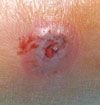- Clinical Technology
- Adult Immunization
- Hepatology
- Pediatric Immunization
- Screening
- Psychiatry
- Allergy
- Women's Health
- Cardiology
- Pediatrics
- Dermatology
- Endocrinology
- Pain Management
- Gastroenterology
- Infectious Disease
- Obesity Medicine
- Rheumatology
- Nephrology
- Neurology
- Pulmonology
Man With Ulcerative Lesion
A 40-year-old man complains of worsening lower extremity discomfort.

THE CASE: A 40-year-old man complains of worsening lower extremity discomfort. He noticed the discomfort several days ago on awakening and thought that he had been bitten by a spider. The lesion, initially a small pustule, has enlarged into an open wound. The patient denies trauma and recent illness; he has no history of serious medical disorders.
What does this look like to you?
- Brown recluse spider bite
- Ecthyma
- Pyoderma gangrenosum
- Impetigo
(Answer and discussion begin on next page.)

DISCUSSION: The patient has pyoderma gangrenosum (PG), an ulcerative lesion of unknown cause that was first described in 1930. In about half of affected patients, PG is associated with a systemic illness. It most commonly affects persons in their fourth or fifth decade and has a slight female predominance. The incidence is 1 per 100,000 population per year, and there is no racial predilection.
Patients often report having been bitten by a spider or other insect. The initial lesion is a pustule or red papule that rapidly worsens and begins to ulcerate. The initial edge of the ulcer may appear bluish. Besides discomfort, symptoms may include malaise and arthralgias.
PG exists as 2 variants: the classic ulcerative form, which typically affects the lower extremities, and a more superficial variant that erupts on the hands. Classic PG may occur around stomal sites, on the genitalia, or intraorally. Histopathologic findings are nonspecific and the lesions are described as sterile neutrophilic abscesses. The lesions may develop in other organ systems, including cardiovascular, pulmonary, GI, ocular, and CNS.
Many patients with PG have a systemic disorder, such as inflammatory bowel disease, leukemia, or symmetric polyarthritis (seronegative or seropositive). Less commonly associated conditions include hepatic diseases; immunologic disorders, such as systemic lupus erythematosus and Sjögren syndrome; and other forms of arthritis, such as osteoarthritis and psoriatic arthritis. In most patients, the diagnosis of a systemic illness occurs before, concurrently with, or after the diagnosis of PG. In as many as 25% of patients, a systemic disease is never diagnosed. Traumatic skin injury (pathergy) may precede PG lesions in up to 30% of patients.
The diagnosis of PG requires the exclusion of disorders that feature similar cutaneous ulcerations. Such disorders include infection, diabetes, malignancy, collagen vascular disease, and trauma. Although histopathologic findings are nonspecific, a biopsy helps rule out other diseases. Routine blood work, including chemistry and liver profiles, complete blood cell count, and VDRL testing, is recommended. Obtain cultures of the lesion for viral, bacterial, fungal, and atypical mycobacterial organisms. Other studies, such as serum and/or urine protein electrophoresis, colonoscopy, bone marrow aspiration, and chest radiography, may be warranted.
No treatment modalities are uniformly effective. Options include systemic therapies (corticosteroids, cyclosporine, dapsone, tumor necrosis factor alpha inhibitors); topical agents (5-aminosalicylic acid, immune modifiers, potent corticosteroids); and intravenous medications (corticosteroids, cyclophosphamide). Surgery is best avoided because it tends to enlarge the wounds (pathergy). Management of underlying conditions may help heal the lesions. Although the prognosis is good, recurrences and residual scarring are not uncommon.
Ecthyma, an infectious ulcerative pyoderma caused by group A Ã-hemolytic streptococci (GABHS), usually affects the legs and occasionally the ankles and feet. Children, patients with diabetes, and immunocompromised persons are most susceptible. Risk factors include a history of skin damage and environmental problems such as crowded living conditions, poor hygiene, and high temperature and humidity.
The lesions of ecthyma initially resemble those of superficial impetigo and consist of pustules or vesicles that overlie an inflamed area. A punched-out ulceration develops with a gray-yellow crust and a surrounding area of erythema and induration. Systemic symptoms are rare, although localized cellulitis, lymphangitis, and adenopathy may occur. Medical therapy involves good hygiene and topical treatment, such as mupirocin ointment, or oral antibiotics (penicillin). Widespread involvement requires parenteral therapy. The lesions of ecthyma heal slowly and often leave a scar.
Impetigo is caused by Staphylococcus aureus or GABHS and is most common in children. Both sexes are equally affected. Variants include bullous impetigo, impetigo contagiosa, and common impetigo. Bullous impetigo typically affects children younger than 2 years.
The lesions appear as tender, erythematous areas with honey-colored crusts periorally or at a site of trauma. Pustules, satellite lesions, and bullae may be present, depending on the type of impetigo. Shallow, erythematous ulcerations and regional lymphadenopathy are sometimes seen.
Management includes good hygiene, wound cleaning, and application of a topical antibiotic agent, such as mupirocin. Systemic antibiotics are required for extensive impetigo or bullous impetigo.
A “bite” wound often implicates the brown recluse spider. These spiders are found mainly in the south central United States. Bites are allegedly rare, even in homes that are heavily infested.
The typical lesion is a painless central papule; surrounding erythema may not emerge for 6 to 12 hours. The wound generally shows signs of progression 48 to 72 hours after the patient has been bitten. Gray to purplish discoloration with central blistering may occur; the lesion is often painful. Bullae, cyanosis, and hyperesthesia sometimes develop. Necrosis and skin sloughing occur occasionally. Severe skin necrosis and other systemic manifestations are uncommon.
Initial management for mild bites consists of local wound care, cold compresses, extremity elevation, and analgesics. Most lesions heal within 2 to 3 months. Antibiotics are administered in the event of surrounding cellulitis or persistent tissue breakdown. Necrotic lesions may require surgical excision if local wound care has failed to produce improvement after several weeks.
